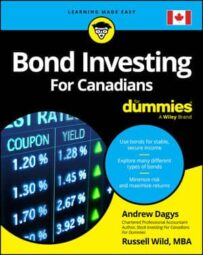How to read bond ratings
Before you buy a bond, get an idea of how much financial muscle the issuer has. Bond ratings are available through any brokerage house. Three of the most popular rating services are Moody’s, Standard & Poor’s, and Fitch. Other rating services exist such as DBRS Morningstar and the smaller A.M. Best, the former having especially strong knowledge of Canadian bond issues. The following table shows the system each of the Big Three agencies uses to rate bonds.
Bond Credit Quality Ratings
| Credit risk ratings | Moody’s | Standard & Poor’s | Fitch |
| Investment grade | |||
| Tip-top quality | Aaa | AAA | AAA |
| Premium quality | Aa | AA | AA |
| Near-premium quality | A | A | A |
| Take-home-to-Mom quality | Baa | BBB | BBB |
| Not investment grade | |||
| Borderline ugly | Ba | BB | BB |
| Ugly | B | B | B |
| Definitely don’t-take-home-to-Mom quality | Caa | CCC | CCC |
| You’ll be extremely lucky to get your money back | Ca | CC | CC |
| Interest payments have halted or bankruptcy is in process | C | D | C |
| Already in default | C | D | D |
Bond ratings are available through any brokerage house.
Questions to ask a bond broker about a bond
As you enter the world of bond investing, you may choose to work with a broker. But use some caution. Ask the questions in the following list — and get acceptable answers — before parting with your cash.
Who is the bond issuer?
Is it the Bank of Canada? Ontario Hydro? City of Vancouver? The Russian Federation? Gus’s Hardware Store? A bond is an IOU, and an IOU is only as good as the entity that owes U. In addition, different kinds of bonds have different characteristics, such as taxability, callability, and volatility.
How is the bond rated?
Especially among Canadian and US corporate bonds (more likely to default than municipal, provincial, or agency bonds), you want to know whether the company issuing the bond is financially stable. Ratings are readily available through any brokerage house.
What is the maturity date?
Long-term bonds tend to pay higher rates of interest, but your money is tied for longer and the price of the bond, should you wish to sell it before maturity, tends to be more volatile.
What is the yield-to-maturity?
There are many ways of measuring a bond’s return. Yield-to-maturity is perhaps the most important measure. (Bond funds, which have no maturity, can be more difficult to compare.)
Is the bond callable?
Can the issuer of the bond hand you back your money at any time? All things being equal, a callable bond is not desirable, and you should get more interest in compensation for the call feature.
What’s the worst-case yield?
Suppose the bond does get called. What would be your yield on the bond at that point? When comparing callable bonds, this figure is very important.
Important websites for bond investors
Successful bond investing isn’t about luck. It’s about researching markets and comparing offers. (And luck.) These six websites serve as your navigation guide through the vast universe of bonds and bond funds.
- FINRA: Find scores of information on US bond yields, prices, and trends at the Financial Industry Regulatory Authority site.
- IIROC and CIRO: IIROC is a Canadian organization that tracks all investment dealers and trading activity on Canada’s debt and equity marketplaces. It stands for the Investment Industry Regulatory Organization of Canada. IIROC’s website will continue to migrate and move items off IIROC.ca to the newly-named Canadian Investment Regulatory Organization (CIRO) at CIRO.ca throughout 2023 and well into 2024.
- Bloomberg: At the Bloomberg site, go to Markets, Market Data, Rates & Bonds for up-to-date information on multiple bond markets.
- Yahoo! Finance: This site offers scads of information on individual bonds and bond funds. Be aware that you’re looking at both news and advertisements, and they get easily jumbled on the screen.
- Moneychimp calculator: Here, you can put in the price of the bond, the coupon rate, and the maturity date, and out comes the all-important yield-to-maturity.

